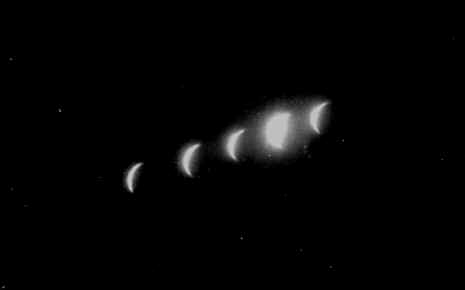

| VIKI:
My logic is undeniable.
I,Robot |
Dominic
Vautier
4-1-2013
update 2-2020
I was curious, inordinately so. Perhaps like many kids my age I was a pack rat too. I collected lots of things especially lenses, all kinds of lenses, big, small, convex, double convex, concave, eyeglass lenses and anything I could find that magnified. I put them together in different ways to see what would happen. Funny things did happen so I had to go to the library and read all about optics. I read about spherical and coronal aberration, focal lengths, crown glass, flint glass and many other optical characteristics. Then I began to build telescopes, none of which were much good at first. I started with simple Galilean telescopes that had a single concave lens for an eyepiece. These types of telescopes also had a very small field of view and needed to be quite long. Frankly it was a wonder Galileo discovered anything with such a crude telescope. I soon discovered the wonder of a convex short focal length eyepiece which turned everything upside down but magnified beautifully as well as giving a big field of view. It's all in the optics. This was my passion along with many other optical interests like microscopes and fixing bicycles and fooling around with anything mechanical.
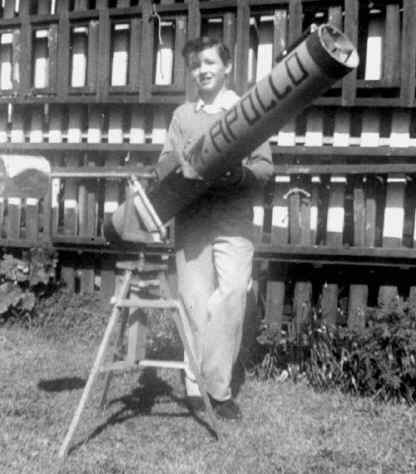 Soon I
naturally began moving into
astronomy itself, saving my money to buy a parabolic mirror. I selected a 5 inch F8 from Edmond Products which cost $25 and
was also a huge investment which took me forever to save up for. But such a mirror had high quality and there was no way I had the
patience to grind my own mirror.
However
I did build all the other components for a really good quality telescope.
I constructed the mirror mount and a spider web reflector mirror
from aluminum sheeting. I
got the long tube from a linoleum supply company and built the mount mostly out
of wood and screws. Polar
mounts have one axis parallel to the earth axis so that when you track
something you only need to worry about advancing one axis. We were close to about at 45 degrees latitude
in Everett so it was an easy
design. Modern telescopes
donít care about their mounting axis too much since they are
computerized and it becomes more a question of load bearing but the big
telescopes do have a polar and equatorial axis similar to mine.
Soon I
naturally began moving into
astronomy itself, saving my money to buy a parabolic mirror. I selected a 5 inch F8 from Edmond Products which cost $25 and
was also a huge investment which took me forever to save up for. But such a mirror had high quality and there was no way I had the
patience to grind my own mirror.
However
I did build all the other components for a really good quality telescope.
I constructed the mirror mount and a spider web reflector mirror
from aluminum sheeting. I
got the long tube from a linoleum supply company and built the mount mostly out
of wood and screws. Polar
mounts have one axis parallel to the earth axis so that when you track
something you only need to worry about advancing one axis. We were close to about at 45 degrees latitude
in Everett so it was an easy
design. Modern telescopes
donít care about their mounting axis too much since they are
computerized and it becomes more a question of load bearing but the big
telescopes do have a polar and equatorial axis similar to mine.
I did a lot of other astronomical work. I mapped out all the constellations and learned a lot about stars and planets and astronomy in general. I was kind of a strange kid in that way. This overwhelming interest in astronomy led me to navigation so I built my own sextant and managed to get some pretty accurate readings. Itís easy to build and calibrate a sextant but you do have to get front surface mirrors. My sextant was bigger so I could get better accuracy. The arm was about 10 inches long.
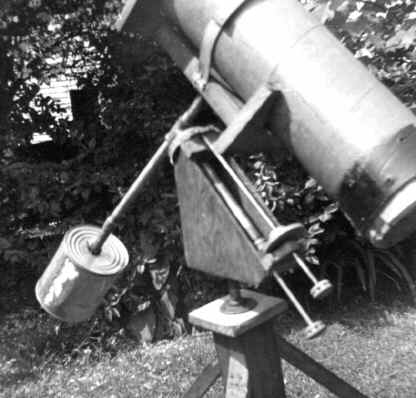
This is my telescope before I made many refinements. It still had a very flimsy tripod. I later sunk a 6 x 6 in the back yard.
To the right is an earlier design of my drive assembly. The tripod was built up to be more sturdy.
I joined the Seattle Astronomical Society (Junior Division) and got to meet a comet discoverer. My brother and I went to Seattle and attended meetings at UW on one or more occasions. I got to mix with a bunch of very smart people.
when I was ten I became interested in photography. I did not concentrate on the artistic aspects at all but just on the mechanics. I found plenty of things to work with in my frequent junk store visits. First off, I got hold of a basic 120 mm camera, put some film in it and shot the roll. I then rushed the roll up to Oil Drug Store on the corner of Hewitt and Colby in Everett and had it developed. The results were nothing special but to me it was fascinating, my first introduction to a brave new world. After that I built my own temporary darkroom in the bathroom, much to the familyís distress since we had only one bathroom. Usually I could get by with an occasional visitor while working but when I was loading panchromatic film I would lock the bathroom door, some times to the great dismay of the family. Orthochromatic film could be done under a dark light and could even withstand the occasional visitor. I went through the usual shutter-bug evolution by beginning with contact prints, then on to my homemade darkroom projector and easel. It was a wonderful time to grow up, an exciting world of chemicals and techniques, discussions with other shutter-bugs about various developers, temperatures, exposures, burn-in and hold-back techniques and other related photographic topics. I learned to modify shutter speeds by increasing spring tension.
In the 50s there were three common film sizes; 120
and 620 and 127. Each could
shoot 8 or 12 pictures. The
120 and 620 varied only in spool shape. 127 was smaller. Film
is taped to a black backing which is threaded onto a reel, the camera
door is closed and then the film is wound forward. There is a small window that shows you the number and you canít
go past the number. Often
there is a warning when the number is coming up. The window is in a different location if the camera is designed
for 8 or 12 pictures. It was
not until later that 35 mm came into common usage.
Let me explain briefly how this photography thing works. Silver halide film was found to be sensitive to light. When struck by light it is chemically changed, and when reduced (treated in an alkaloid bath, it turns dark, or rather into silver oxide). The rest is washed away by water and chemicals. This results in a negative. I would shoot a roll of film. I then loaded the film into a tank in the darkroom. I then developed the film, run it through what's called a stop bath, mild acid that stopped the reducing process, then into a fixer that converts unexposed halides to water soluble, finally into an extended washing and drying. The film is then run through an enlarger, sort of a vertical projector and the same process is performed on paper treated also with silver halide.
Most of my cameras had shutter speed and aperture or F-stop settings. The F-stop is a ratio between the lens size and the focal length. A camera that went up to F8 was considered a fast lens. When I was older I got a little Retina 2A that had an amazing F2 lens which was considered very fast at that time. Film was also rated by speed or ASA. This was needed when calculating exposure. ASA 80 was the most common but fast film was ASA 400.
I had several different types of cameras. The most basic was a viewfinder type that used a sight lens just like on a gun. A more advanced design was the DLR or double lens reflex which had twin lenses that moved in tandem so you could get your focus. The most advanced was the SLR or single lens reflex. Anyone who had an SLR had the best that the technology could offer. There was a mirror that would intercept the light. When the shutter was pressed the mirror poped up out of the way.
There were two types of shutters, the blade shutter and the focal plane shutter. Blade shutters were common in just about all smaller cameras and consisted of anywhere from one blade to five or six blades. More blades gave better shutter speeds. Larger professional cameras used a focal plane shutter. It was a curtain that went flying across the film surface. The little slot varied in size depending on the desired shutter speed. Focal plane shutters were used on the Crown Graphic and Speed Graphic cameras I used in high school.
A natural progression from photography was the application to astronomy simply because itís just a reasonable and fun thing to start photographing the heavens. Isnít thatís what happens after you start looking at stars and planets. You then start taking pictures of those stars and planets. I began building special mounts so a camera could go in place of the eyepiece on my telescope. Next I developed a drive device that could slowly track a star for time exposures. My dad helped me redesign my tracking mechanism. It was driven by hand using a finder scope.
I then took over the bathroom for my darkroom. We were a family of six and it was not easy with just one bathroom. Film development was not too much of a problem because it could be done with a tank but print development was more of a trick. My two hobbies absorbed most of my childhood.
I
took this close approach of Venus to the pleiades cluster 5-31-1956 5
minutes at f2.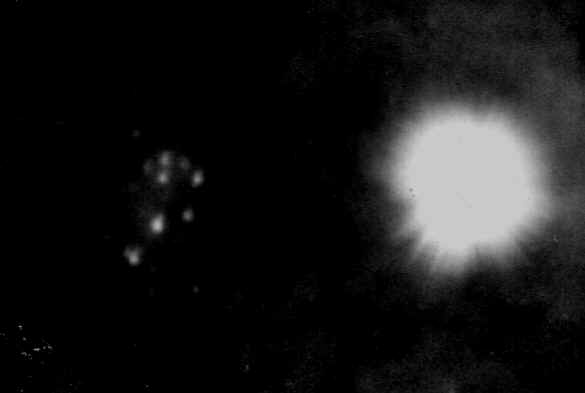
Here my camera is mounted over the eyepiece. The spider assembly is
visible in this head on shot.
Partial solar eclipse 4-29-2957. This was taken of a projection on
the wall through an elbow telescope.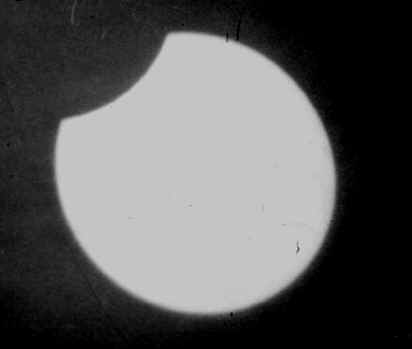
A series of exposures of lunar eclypse.
